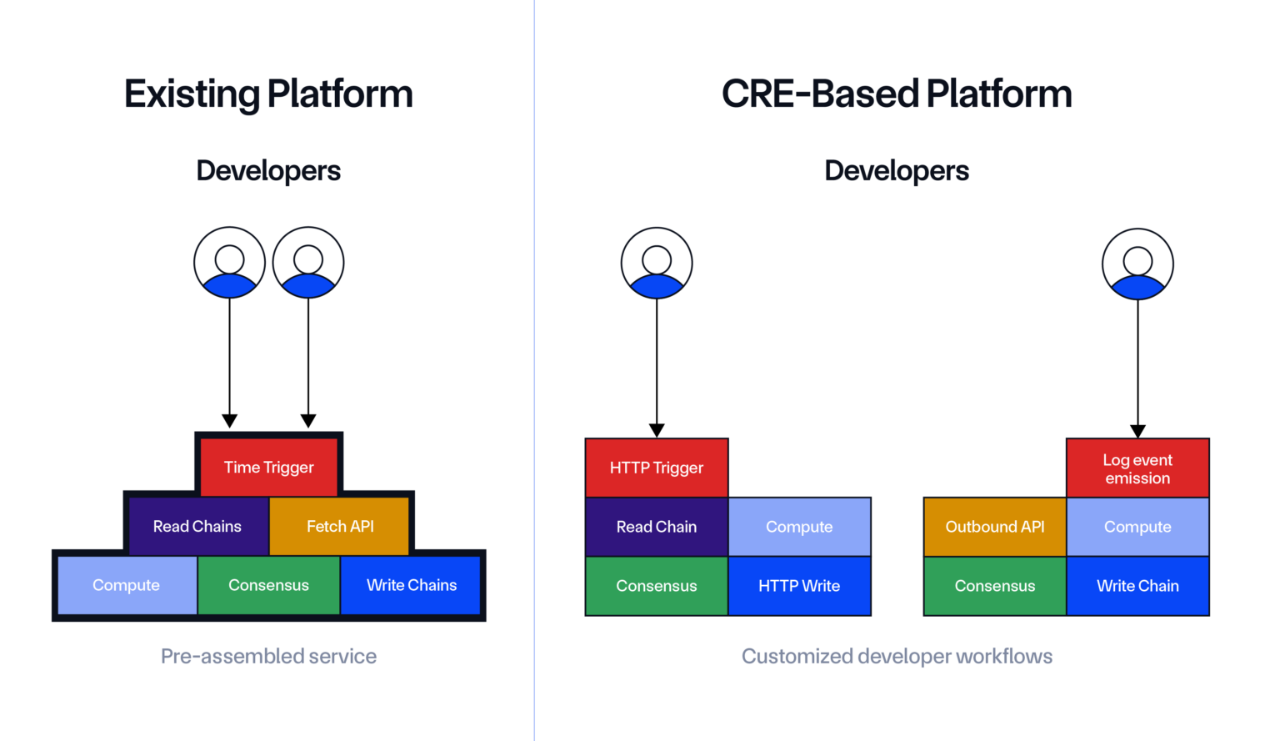The Chainlink Runtime Environment (CRE) is a revolutionary platform that simplifies smart contract development by managing complex workflows, potentially matching the transformative impact of the Ethereum Virtual Machine (EVM) on blockchain technology.
-
CRE reduces smart contract development time from months to weeks or days by abstracting complex on- and off-chain interactions.
-
It functions as an operating system for Chainlink, orchestrating decentralized oracle networks across multiple blockchains.
-
CRE supports JavaScript, TypeScript, and Go, enabling developers to build scalable, cross-chain applications with enhanced security features like zero-knowledge proofs.
Chainlink Runtime Environment (CRE) transforms smart contract development with faster workflows and cross-chain support. Discover how CRE matches Ethereum Virtual Machine’s impact.
What is the Chainlink Runtime Environment (CRE)?
The Chainlink Runtime Environment (CRE) is a groundbreaking platform launched in late 2024 that enables developers to deploy code directly on the Chainlink network without embedding Chainlink-specific code in on-chain contracts. It acts as an operating system for Chainlink, orchestrating complex workflows that integrate price feeds, cross-chain messaging, APIs, zero-knowledge proofs, and compliance checks.
How does CRE simplify smart contract development?
CRE abstracts the complexity of interconnected on- and off-chain systems by managing decentralized oracle networks (DONs) that handle blockchain reads, API data fetching, consensus, and on-chain writing. This abstraction reduces development time significantly, turning months of work into weeks or days, according to Chainlink co-founder Sergey Nazarov.

How to build on the Chainlink Runtime Environment?
Developers can write CRE workflows using JavaScript, TypeScript, or Go. The CRE coordinates the actions of Chainlink’s decentralized oracle networks to ensure cryptographic consensus and deliver results to smart contracts, independent of the underlying blockchain.
The architecture supports multiple chains and includes native features for confidential computing and zero-knowledge proofs, enhancing security and privacy in decentralized applications.
What recent developments showcase CRE’s capabilities?
In mid-2025, Chainlink collaborated with JPMorgan’s Kinexys and Ondo Finance to complete a cross-chain delivery versus payment settlement using the CRE, demonstrating its ability to bridge permissioned payment networks with public blockchains. JPMorgan’s Kinexys is actively working to integrate institutional-grade payment infrastructure with emerging on-chain assets, highlighting CRE’s growing adoption in traditional finance.
Why is CRE considered transformative like the Ethereum Virtual Machine?
The Ethereum Virtual Machine (EVM) revolutionized blockchain by enabling Turing-complete smart contracts, drastically reducing development time and complexity. Similarly, CRE introduces a new layer of abstraction that simplifies the orchestration of complex workflows across multiple blockchains and off-chain systems, potentially accelerating decentralized application development and adoption.
What expert insights support CRE’s impact?
Sergey Nazarov emphasized that CRE’s ability to reduce development timelines and manage complex ecosystems positions it as a transformative technology. Industry leaders at JPMorgan’s Kinexys also recognize CRE’s potential to merge traditional finance with blockchain, underscoring its authoritative role in advancing decentralized infrastructure.
Frequently Asked Questions
How does CRE improve blockchain interoperability?
CRE enables seamless communication between different blockchains by orchestrating decentralized oracle networks, allowing smart contracts to interact across chains securely and efficiently.
What programming languages are supported by CRE?
Developers can build CRE workflows using JavaScript, TypeScript, and Go, facilitating flexible and accessible smart contract development.
Key Takeaways
- CRE simplifies smart contract development: It reduces complexity by abstracting on- and off-chain interactions.
- Cross-chain functionality: CRE supports multiple blockchains with native security features.
- Industry adoption: Partnerships with JPMorgan’s Kinexys demonstrate CRE’s growing institutional relevance.
Conclusion
The Chainlink Runtime Environment represents a significant advancement in blockchain technology by streamlining smart contract workflows and enabling cross-chain interoperability. As CRE gains traction among developers and financial institutions, it is poised to reshape decentralized application development and bridge traditional finance with blockchain innovation.
